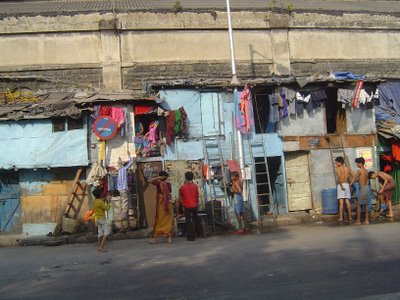I clicked this photo a couple of days ago, on my way to work.
This is P D'Mello Marg, an arterial road that goes by the docks and is always filled with trucks (which explains that No Parking sign!).
As you can see, every house on this street is two-storeyed, with a ladder stacked up against it. To keep your balance on the ladder (like the guy in the blue shirt is doing), you hang on a piece of rope cleverly left dangling from the washing line. An ingenious contraption, I thought. See if you can spot the rope for the other ladders as well!
 Another thing I noticed is that all doors have numbers on them, marking the legal right of the owner to live there. They are registered with the Mumbai municipality. So the man in the blue shirt is Mr. Somebody, in this city of illegal hutments.
Another thing I noticed is that all doors have numbers on them, marking the legal right of the owner to live there. They are registered with the Mumbai municipality. So the man in the blue shirt is Mr. Somebody, in this city of illegal hutments.
The other type of houses in India where neighbours share walls is at the highest end of the caste spectrum - the houses of the Tamil Brahmins. Here is a Brahmin street (an agraharam). The joining of the houses signifies more than just neighbourly acceptance. It is a sign that they are all the same community and can live and eat together without losing caste.
walls is at the highest end of the caste spectrum - the houses of the Tamil Brahmins. Here is a Brahmin street (an agraharam). The joining of the houses signifies more than just neighbourly acceptance. It is a sign that they are all the same community and can live and eat together without losing caste.
In the slums of Bombay, the old caste rules are breaking down as people jostle for space. It is a welcome fall-out of the overcrowding that we all moan about so much.
This is P D'Mello Marg, an arterial road that goes by the docks and is always filled with trucks (which explains that No Parking sign!).
As you can see, every house on this street is two-storeyed, with a ladder stacked up against it. To keep your balance on the ladder (like the guy in the blue shirt is doing), you hang on a piece of rope cleverly left dangling from the washing line. An ingenious contraption, I thought. See if you can spot the rope for the other ladders as well!
 Another thing I noticed is that all doors have numbers on them, marking the legal right of the owner to live there. They are registered with the Mumbai municipality. So the man in the blue shirt is Mr. Somebody, in this city of illegal hutments.
Another thing I noticed is that all doors have numbers on them, marking the legal right of the owner to live there. They are registered with the Mumbai municipality. So the man in the blue shirt is Mr. Somebody, in this city of illegal hutments.The other type of houses in India where neighbours share
 walls is at the highest end of the caste spectrum - the houses of the Tamil Brahmins. Here is a Brahmin street (an agraharam). The joining of the houses signifies more than just neighbourly acceptance. It is a sign that they are all the same community and can live and eat together without losing caste.
walls is at the highest end of the caste spectrum - the houses of the Tamil Brahmins. Here is a Brahmin street (an agraharam). The joining of the houses signifies more than just neighbourly acceptance. It is a sign that they are all the same community and can live and eat together without losing caste.In the slums of Bombay, the old caste rules are breaking down as people jostle for space. It is a welcome fall-out of the overcrowding that we all moan about so much.



1 comment:
Another point of view is that these shanties are an eyesore, that creates tremendous problems for the city. In my first week back in India, I saw a woman bathing her kid with water that runs off the cement pipes from one of the factories (mills??) in that area. Cant believe you compared it to agraharams and then gave it some kind of a weird communal twist!!!
Post a Comment